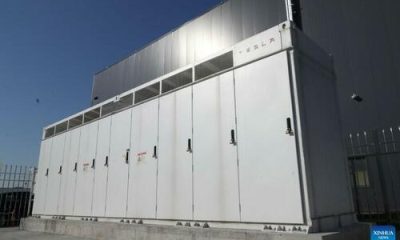Energy & Critical Metals
Uranium is Heating Up – Here’s Why Investors Should be Excited
Uranium demand is starting to really heat up Processing a bottleneck as utilities avoid dependence on Russia Urgency expected to … Read More
The post…

- Uranium demand is starting to really heat up
- Processing a bottleneck as utilities avoid dependence on Russia
- Urgency expected to creep towards yellowcake production
Sentiment about uranium continues to improve with some commentators noting that the disruption to energy markets caused by the Russian invasion of Ukraine could lead to a sustained growth in demand.
This could also hit nuclear utilities in their pocketbooks more than increased demand would imply with Deep Yellow managing director John Borshoff telling Stockhead earlier this month that uranium pricing could get out of utilities’ hands if they continued to ‘lowball’ producers.
So just how did we get to this point and is the uranium market really poised for growth?
Speaking to Stockhead ahead of PAC Partners’ Uranium Forum in Sydney today, PAC Partners senior equities analyst Lawrence Grech noted that prior to the Global Financial Crisis in 2007-08, uranium prices were very high and provided the incentive to bring on a lot of production.
“We had the dramatic expansion of the industry in Kazakhstan and they became the world’s largest producer and for a number of years after that, even though the uranium market started to come down quite heavily, they were continuing to open up capacity,” he explained.
This combined with the decommissioning of nuclear weapons meant that there was a lot of material on the market before the bottom fell out of it.
“What that did was very quickly after that, except for Kazakhstan, new capacity and developments was really stopped in their tracks, and indeed progressively a number of mines – some of the best grade mines in the world – and other operations either ran out of economic ore or they were shut-in because prices were effectively too low,” Grech added.
“Of course, in the intervening period we had the Fukushima disaster and the subsequent shut-in of much of Japan’s and, for separate reasons, Korea’s reactors.”
Things changed in the last half decade when demand started picking up again as the market actually went into deficit and a lot of the stock overhang was taken away.
“The uranium market is extremely tight and becoming tighter all the time and that process was given a very important kick along by the introduction of a fund run by Sprott, which by investing in uranium rather than uranium stocks, actually took away a lot of the surplus uranium available to the ultimate processors and generators,” Grech noted.
“This confluence of factors have seen prices come from very low levels, below US$20 a pound and to settle at about US$50/lb now.”
While US$50/lb is seen as still too low to incentivise new production, he noted that markets are becoming more anticipatory now as tightness starts being felt at the ultimate end of the processing chain – where material is encased in fuel rods for use in nuclear reactors.
Processing to drive prices
Grech explained that processing capacity is becomingly increasingly squeezed as one got closer to fuel rod construction, which is complicated further by about 38% to 39% of global processing capacity being possessed by the Russians.
“People are uncomfortable tying all their supply eggs to the Russian basket, given their track record in denying Europe natural gas and coal supplies, so the sense of urgency at the processing end has been very high,” he added.
“A degree of that urgency will be creeping back towards the production of a yellowcake that will go into that production system, which is a very important dynamic in the market.
“The uranium oxide market itself has yet to factor in all that element of tightness in my opinion but prices will follow once people understand the bottleneck.”
Higher prices will also provide the incentive for financiers to provide funding for new developments to make up for the ageing production or to cater for new demand that’s emerging.
Why should investors buy uranium?
Given these factors, it should come as no surprise at all that Grech believes investors should be having a good, hard look at investing in uranium companies.
“I think we are embarked upon one of the single largest changes in the industrial structure of the world and the energy transition – and the fuels that run it – is an important part of that,” he told Stockhead.
“The inputs into this energy transition are absolutely front and centre. And if we’re talking about decarbonising for climate change reasons, of course uranium has a very low emissions footprint as well as renewable energy.”
The statistics are telling. According to BP’s world energy figures, uranium provided 7% of the world’s primary energy in 2000 and just 4.25% last year.
Meanwhile, renewables provided 6.8% of the world’s total primary energy.
“If we want to get a majority of our power – I’m not talking about 100%, I’m talking 50% here – from zero emissions sources, the market share of both renewables and uranium has to increase by four times by 2050,” Grech pointed out.
The International Atomic Energy Agency is a little more conservative, noting that nuclear generation needs to hit at least 820 gigawatts to help achieve net zero, which is a little more than twice the current 393GW.
“And when I look at the World Nuclear Association, there are 437 reactors operating in the world today while there are about 59 under construction,” Grech noted.
“That’s quite good, but if you look at all those under construction, the planned and the proposed, they amount to about 493 reactors, so that’s bigger than the present fleet and consistent with the IAEA’s forecasting of a significantly more than doubling the nuclear industry.”
He also acknowledged that while the general public might focus on the military aspects of nuclear or accidents such as Fukushima, outstanding developments in reactor design would go a long way towards addressing concerns.
“Not only are these new generation reactors safer, there is a trend towards these small modular reactors and effectively for important components you’re talking about factory assembly,” he explained.
“With factory assembly comes strict quality control and much better ability to lower your capital cost.
“For me, when you get quality control then those reactor builds become ever more bankable and supportable by government policy because we need to meet our emissions reductions targets. And they will be safer as well.”
Grech added that besides playing the yellowcake story, investors could also capitalise on the need for specialist metals that go into the new reactors.
For new uranium supply, he pointed towards activity in three broad areas – the Athabasca Basin in Canada, Africa and western United States.
“The Athabasca Basin is a premier basin for very high-grade uranium, though you have to take into account environmental and permitting issues,” he noted.
“But the Athabasca Basin is a good centre for exploration and we do have a couple of companies that are actively exploring and new explorers in the Athabasca Basin.
“For example, 92 Energy (ASX:92E) who on their first drill campaign made a brand new discovery called the Gemini Trend, and others like Basin Energy that only very recently listed.”
Namibia is also getting a relook with Grech highlighting Bannerman Energy (ASX:BMN) and its Etango deposit, which it is redefining to be smaller scale but more easily financed in this market, while Aura Energy (ASX:AEE) is also closing in on a development decision for its project in Mauritania.
Grech also highlighted companies such as Thor Mining (ASX:THR) who were looking to exploit the Uravan belt on the border of Utah and Colorado again where the deposits tended to be small but high quality.
Consideration can also go into companies like Cameco and Silex as well as companies that provide services to this strongly growing industry.
And while it remains anyone’s guess into whether nuclear will play a role in Australia’s future generation mix, he is confident that we will remain involved at the beginning from mining down to some of the processing stages.
At Stockhead, we tell it like it is. While Aura Energy is a Stockhead advertiser, it did not sponsor this article.
The post Uranium is heating up – here’s why investors should be getting excited appeared first on Stockhead.

Uranium Exploration Company Announces Additional Staking in the Athabasca Basin
Source: Streetwise Reports 12/22/2023
Skyharbour Resources Ltd. announced an update from its Canada-based Falcon Project along with additional…
Tesla Launches New Mega Factory Project In Shanghai, Designed To Manufacture 10,000 Megapacks Per Year
Tesla Launches New Mega Factory Project In Shanghai, Designed To Manufacture 10,000 Megapacks Per Year
Tesla has launched a new mega factory…
Giving thanks and taking stock after “a remarkable year”
An end-of-year thank you to our readers, industry colleagues and advertisers before Electric Autonomy breaks from publishing until Jan. 2
The post Giving…
















